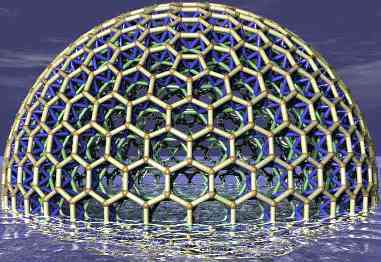
HexDome

Eden Fabric Stability
|
A light, sparse fabric
The Eden Project fabric has fewer struts than practically
any other double-layer dome design. Its sparsenss saves
weight, money - and allows in lots of sunlight.
However it does suffer from some structural issues
as a result of its lack of stabilising struts.
Stability issues
If you've ever constructed a dome made using the same fabric
as the Eden Project domes, you may have noticed that one of
the ways in which is is most likely to move involves
alternate tetrahedra in its truss rotating in opposite
directions.
In fact the whole fabric is fundamentally a flexible one -
and is free to move in two different ways - unless it is
anchored down.
Diagrams
Some diagrams will help explain the idea. Firstly the
following diagrams identify six tetrahedra in the truss:

Unit cell
|
|

Tetrahedra marked
|
|
The basic idea is that - on a small scale - the red
tetrahedrda could rotate one way, while the green
tetrahedrda could rotate the other way, while facing
minimal resistance.
Next, consider this neodymium model of the Eden Project
fabric:

Top side of the fabric
|
The view from underneath looks like this:

Underside of the fabric
|
...and if you try to twist alternating tetrahedra in
opposite directions, the result looks like this:

Tetrahedra twisted in alternating directions
|
As the last picture illustrates, alternating tetrahedra in
the truss are relatively free to rotate in opposite
directions.
Rotating the tetrahedra in this way increases the overall
curvature of the dome locally - but is not resisted by the
fabric in any other way.
Linear stability analysis
Linear stability analysis
suggests that the fabric acutally lacks linear stability in
the face of this type of small perturbation of the tetrahedral
layer - assuming that this is free to move at its edges.
Lack of linear stability can be associated with structures
that are prone to vibration. Vibration in metal structures
may increase the risk of metal fatigue. It seems like an
undesirable characteristic for a structural fabric.
Implications
The fact that this fabric can be deformed in this way raises
a few issues for dome builders.
Firstly, the lack of resistance of the fabric to this type
of transformation is ameliorated when it is bent into a full
dome - because the rotating elements no longer all link
together in structures with an even number of elements.
Instead of forming rings of six tetrahedra, a dome
throws in a few pentagons into the structure - where
five tetrahedra are linked together.
The fact that five is an odd number means that the pentagons
act to stabilise the resulting structure - since alternating
tetrahdra around a pentagon is impossible.
Consequently, a dome built from this fabric gains stability
from its pentagonal elements.
There's may also be a slight gain in stability as a result
of the tetrahadra not all necessarily being exactly the same
size.
Having a structure be stable because it is anchored
intermittently is sometimes acceptable - provided the
anchors occur regularly enough. If this type of fabric was
used in a large enough dome, there would be areas which were
far from any pentagonal anchor - and imperfections at the
joints may accumulate and allow some resulting movement.
Remedies
Throwing in a few more struts in the internal layer seems
like it would be effective at preventing these degrees of
freedom. Additional structural elements could be placed at
the points which are furthest from any pentagonal elements,
to act as additional anchoring points.
Flexibility
In addition to the issue associated with lack of resistance
to rotation of the tetrahedra forming the truss, the fabric
is also flexible in another way.
In particular, it can be bent into anticlastic curved surfaces.
In this respect the fabric closely resembles a thin square
section octet truss fabric.
The following photographs illustrate that transformation:

Fabric bent into an anticlastic surface
|

Fabric bent into an anticlastic surface
|
This type of flexibility presents other issues to dome
designers - particularly during construction, when the dome
shape is incomplete. In particular it makes additional
elements - not present in the final structure -
necessary. These act as scaffolding during the
construction process.
Tim Tyler |
Contact |
http://hexdome.com/
|